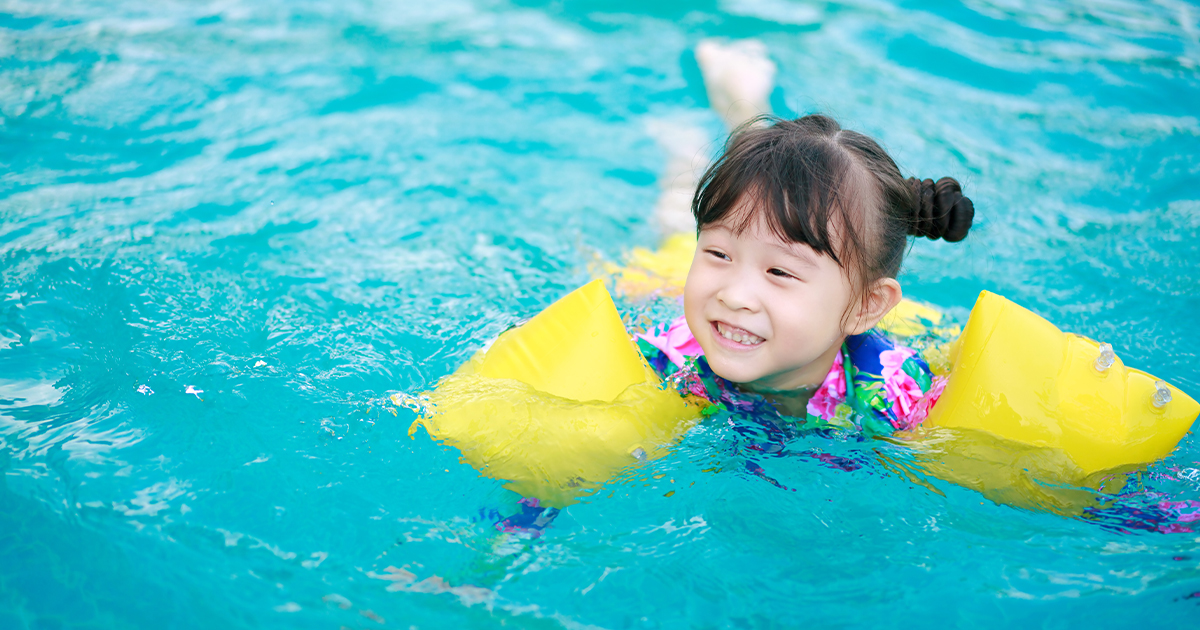Lakes, ponds and swimming pools are the best part of summer. Here's how to make a splash with precautions top of mind.
Whether cannonballing into the deep end or splashing in big lake waves, fun in the water is one of the best reasons to live in Michigan. Unfortunately, water can also be dangerous.
Children are especially vulnerable. Drowning is the No. 1 cause of injury-related death among kids ages 1 to 4 and the third-leading cause of unintentional injury-related death among those 19 and younger.
A handful of simple guidelines can help keep your family safe, said Katelyn Jansheski, injury prevention coordinator for Spectrum Health Zeeland Community Hospital.
It's important to understand that a child's fascination with water is part of the risk. It's up to adults to set good examples for safety and fun.
"Children are very curious and that's how they learn," Jansheski said. "Even if you think they are already safe around the water or not that adventurous, keep talking to them—and make sure someone always has their eyes on them."
That means engaging them in conversations about water safety at each outing, understanding that different splash points pose different risks.
Any water is a potential hazard. Kids can drown in as little as 2 inches of water.
But open water is more dangerous than swimming pools. There are waves, riptides and currents. Visibility is often poor, hiding sudden drop-offs or submerged rocks and logs. Extreme water temperatures can put even the strongest adult swimmers at risk.
Here are some tips to improve water safety:
1. Trust the safety experts
Adults should first look for beaches with lifeguards. Once you're there, obey hazard warnings. "If lifeguards have set up red flags to stop swimming, there's a reason," Jansheski said.
2. Check pool fences
In Michigan, a pool must be surrounded by a sturdy fence that's at least 4 feet high. Often, homeowners don't maintain them well, or they get in the habit of leaving gates unlatched. When visiting friends, families or resorts, do a quick walk-around, ensuring the fence is fully functioning.
3. Learn how to fit a life jacket
U.S. Coast Guard-approved personal flotation devices are required for kids in boats. These devices can offer plenty of peace of mind at pools and beaches, but they can be tricky to fit.
Make sure the device is the right size for your child's weight. Snug the straps up and then lift at the shoulders. If it can reach your child's chin or ears, it's too large. (Watch this demonstration video for tips.)
4. Know the power—and limits—of swimming lessons
Ideally, all kids should learn to swim. It's fun, great exercise and builds confidence. But it's important to remember that plenty of good swimmers drown every year. And a child may swim well but be utterly unprepared for rescuing someone else.
For children to be safe in open water, they need to be able to do five things, Jansheski said:
- Jump into water over their head
- Orient toward safety
- Float or tread water
- Combine breathing with forward movement (even if it's just a doggie paddle)
- Exit the water
5. Choose a water watcher
Whether you're at the beach, the pool or on a boat, social gatherings can distract adults from watching kids. "Appoint someone specifically to watch the kids for 15 minutes, then the next one, and so on," Jansheski said.
This gives the other parents time to socialize, read, look at their phones, or relax.
6. Consider taking a class
Many families only occasionally head into the water. But if it's a constant part of family life—and especially if you have a pool or a cabin on a lake—consider taking basic water rescue classes and a CPR class.
CPR and first-aid classes are available at Spectrum Health. The American Red Cross also offers training in Michigan.
7. Monitor horseplay
Chicken fights and dunking one another may seem harmless, but they can lead to injury and drowning. Make sure water games don't get too rough, especially for smaller children.
8. Pay attention to close calls
Most of the time, a child who accidentally goes underwater will cough and splutter and then shake it right off.
But in very rare cases, kids can suffer from either dry drowning or secondary drowning, Jansheski said. While rare, these events can be serious. For 24 hours after the incident, be on the lookout for persistent coughing, trouble talking, lethargy, sleepiness and vomiting. At any sign the child is struggling for breath, call 911 or head to the emergency room.
9. Revisit the rules—often
Get ready to repeat yourself as you present these rules and guidelines to kids. They'll likely need to hear it more than once.
"It's easy for parents to think that kids will remember safety rules from day to day," Jansheski said. "But they don't."
Written by Sarah Mohoney for Spectrum Health's Health Beat Blog.
This article was republished with permission and originally appeared at Spectrum Health's Health Beat Blog.




